SPICE Implementation of the Dynamic Memdiode Model for Bipolar Resistive Switching Devices
Abstract
:1. Introduction
2. Dynamic Memdiode Model (DMM)
2.1. Current-Voltage Characteristic
2.2. Memory State Equation
| Algorithm 1: Memdiode script for LTSpice XVII. + and − are the device terminals. H is the memory state output. The colors indicate the different sections: parameter values, memory equation, I-V characteristic, and auxiliary functions. | |
| 1 | .subckt memdiode + − H |
| 2 | *created by E.Miranda, F. Aguirre and J.Suñé, revised January 2022 |
| 3 | .params |
| 4 | + H0 = 0 ri = 50 RPP = 1E10 |
| 5 | + etas = 50 vs = 1.4 |
| 6 | + etar = 100 vr = −0.4 |
| 7 | + ion = 1E-2 aon = 2 ron = 10 |
| 8 | + ioff = 1E-7 aoff = 2 roff = 10 |
| 9 | + vt = 0.4 isb = 2E-4 gam = 1; isb = 1/gam = 0 no SB/SF |
| 10 | *Memory Equation |
| 11 | BI 0 H I = if(V(+,-)> = 0, (1-V(H))/TS(V(C,-)),-V(H)/TR(V(C,-))) |
| 12 | CH H 0 1 ic = {H0} |
| 13 | *I-V |
| 14 | RI + C {ri} |
| 15 | RS C B R = K(ron,roff) |
| 16 | BF B - I = K(ion,ioff)*sinh(K(aon,aoff)*V(B,-)) |
| 17 | RB + - {RPP} |
| 18 | *Auxiliary functions |
| 19 | .func K(on,off) = off+(on-off)*limit(0,1,V(H)) |
| 20 | .func TS(x) = exp(-etas*(x- if(I(BF)>isb,vt,vs))) |
| 21 | .func TR(x) = exp(etar* if(gam = = 0,1,pow(limit(0,1,V(H)),gam))*(x-vr)) |
| 22 | .ends |
3. Simulation Results and Discussion
3.1. Memory State Equation
3.2. Switching Dynamics
3.3. CRS Devices
4. Experimental Validation
5. Conclusions
Supplementary Materials
Author Contributions
Funding
Data Availability Statement
Acknowledgments
Conflicts of Interest
References
- Ielmini, D.; Milo, V. Physics-based modeling approaches of resistive switching devices for memory and in-memory computing applications. J. Comput. Electron. 2017, 16, 1121–1143. [Google Scholar] [CrossRef] [PubMed] [Green Version]
- Banerjee, W.; Kim, S.H.; Lee, S.; Lee, S.; Lee, D.; Hwang, H. Deep Insight into Steep-Slope Threshold Switching with Record Selectivity (>4 × 1010) Controlled by Metal-Ion Movement through Vacancy-Induced-Percolation Path: Quantum-Level Control of Hybrid-Filament. Adv. Funct. Mater. 2021, 31, 1–9. [Google Scholar] [CrossRef]
- Niraula, D.; Karpov, V. Comprehensive numerical modeling of filamentary RRAM devices including voltage ramp-rate and cycle-to-cycle variations. J. Appl. Phys. 2018, 124, 174502. [Google Scholar] [CrossRef] [Green Version]
- Lin, J.; Liu, H.; Wang, S.; Zhang, S. Modeling and Simulation of Hafnium Oxide RRAM Based on Oxygen Vacancy Conduction. Crystals 2021, 11, 1462. [Google Scholar] [CrossRef]
- Strukov, D.B.; Snider, G.S.; Stewart, D.R.; Williams, R.S. The missing memristor found. Nature 2008, 453, 80–83. [Google Scholar] [CrossRef] [PubMed]
- Blasco, J.; Ghenzi, N.; Suñé, J.; Levy, P.; Miranda, E. Equivalent circuit modeling of the bistable conduction characteristics in electroformed thin dielectric films. Microelectron. Reliab. 2015, 55, 1–14. [Google Scholar] [CrossRef]
- Chua, L. Resistance switching memories are memristors. Appl. Phys. A 2011, 102, 765–783. [Google Scholar] [CrossRef] [Green Version]
- Yakopcic, C.; Taha, T.M.; Subramanyam, G.; Pino, R.E. Generalized memristive device SPICE model and its application in circuit design. IEEE Trans. Comput. Des. Integr. Circuits Syst. 2013, 32, 1201–1214. [Google Scholar] [CrossRef]
- Kvatinsky, S.; Friedman, E.G.; Kolodny, A.; Weiser, U.C. TEAM: Threshold adaptive memristor model. IEEE Trans. Circuits Syst. I Regul. Pap. 2013, 60, 211–221. [Google Scholar] [CrossRef]
- Kvatinsky, S.; Ramadan, M.; Friedman, E.G.; Kolodny, A. VTEAM: A General Model for Voltage-Controlled Memristors. IEEE Trans. Circuits Syst. II Express Briefs 2015, 62, 786–790. [Google Scholar] [CrossRef]
- Eshraghian, K.; Kavehei, O.; Cho, K.R.; Chappell, J.M.; Iqbal, A.; Al-Sarawi, S.F.; Abbott, D. Memristive device fundamentals and modeling: Applications to circuits and systems simulation. Proc. IEEE 2012, 100, 1991–2007. [Google Scholar] [CrossRef] [Green Version]
- Biolek, D.; Biolek, Z.; Biolkova, V.; Kolka, Z. Modeling of TiO2 memristor: From analytic to numerical analyses. Semicond. Sci. Technol. 2014, 29, 2–7. [Google Scholar] [CrossRef]
- Biolek, D.; Biolek, Z.; Biolkova, V.; Kolka, Z. Reliable modeling of ideal generic memristors via state-space transformation. Radioengineering 2015, 24, 393–407. [Google Scholar] [CrossRef]
- Yang, J.J.; Strukov, D.B.; Stewart, D.R. Memristive devices for computing. Nat. Nanotechnol. 2012, 8, 13–24. [Google Scholar] [CrossRef]
- Kim, B.G.; Yeo, S.; Lee, Y.W.; Cho, M.S. Comparison of diffusion coefficients and activation energies for ag diffusion in silicon carbide. Nucl. Eng. Technol. 2015, 47, 608–616. [Google Scholar] [CrossRef] [Green Version]
- Panda, D.; Sahu, P.P.; Tseng, T.Y. A Collective Study on Modeling and Simulation of Resistive Random Access Memory. Nanoscale Res. Lett. 2018, 13, 1–48. [Google Scholar] [CrossRef]
- Hajri, B.; Aziza, H.; Mansour, M.M.; Chehab, A. RRAM Device Models: A Comparative Analysis with Experimental Validation. IEEE Access 2019, 7, 168963–168980. [Google Scholar] [CrossRef]
- Ielmini, D. Brain-inspired computing with resistive switching memory (RRAM): Devices, synapses and neural networks. Microelectron. Eng. 2018, 190, 44–53. [Google Scholar] [CrossRef]
- Aguirre, F.L.; Pazos, S.M.; Palumbo, F.; Suñé, J.; Miranda, E. SPICE Simulation of RRAM-Based Crosspoint Arrays Using the Dynamic Memdiode Model. Front. Phys. 2021, 9, 548. [Google Scholar] [CrossRef]
- Aguirre, F.L.; Gomez, N.M.; Pazos, S.M.; Palumbo, F.; Suñé, J.; Miranda, E. Minimization of the Line Resistance Impact on Memdiode-Based Simulations of Multilayer Perceptron Arrays Applied to Pattern Recognition. J. Low Power Electron. Appl. 2021, 11, 9. [Google Scholar] [CrossRef]
- Aguirre, F.L.; Pazos, S.M.; Palumbo, F.; Suñé, J.; Miranda, E. Application of the Quasi-Static Memdiode Model in Cross-Point Arrays for Large Dataset Pattern Recognition. IEEE Access 2020, 8, 202174–202193. [Google Scholar] [CrossRef]
- Aguirre, F.L.; Pazos, S.M.; Palumbo, F.; Antoni, M.; Suñé, J.; Miranda, E.A. Assessment and Improvement of the Pattern Recognition Performance of Memdiode-Based Cross-Point Arrays with Randomly Distributed Stuck-at-Faults. Electronics 2021, 10, 2427. [Google Scholar] [CrossRef]
- Miranda, E. Compact Model for the Major and Minor Hysteretic I-V Loops in Nonlinear Memristive Devices. IEEE Trans. Nanotechnol. 2015, 14, 787–789. [Google Scholar] [CrossRef]
- Patterson, G.A.; Sune, J.; Miranda, E. Voltage-Driven Hysteresis Model for Resistive Switching: SPICE Modeling and Circuit Applications. IEEE Trans. Comput. Des. Integr. Circuits Syst. 2017, 36, 2044–2051. [Google Scholar] [CrossRef] [Green Version]
- Sune, J.; Miranda, E.; Nafria, M.; Aymerich, X. Point contact conduction at the oxide breakdown of MOS devices. In Proceedings of the Technical Digest—International Electron Devices Meeting; IEEE: New York, NY, USA, 1998; pp. 191–194. [Google Scholar]
- Miranda, E.; Suñé, J. Analytic modeling of leakage current through multiple breakdown paths in SiO2 films. In Proceedings of the IEEE International Reliability Physics Symposium Proceedings; Institute of Electrical and Electronics Engineers Inc.: New York, NY, USA, 2001; Volume 2001, pp. 367–379. [Google Scholar]
- Miranda, E.; Suñé, J. Electron transport through broken down ultra-thin SiO2 layers in MOS devices. Microelectron. Reliab. 2004, 44, 1–23. [Google Scholar] [CrossRef]
- Miranda, E.; Walczyk, C.; Wenger, C.; Schroeder, T. Model for the Resistive Switching Effect in HfO2 MIM Structures Based on the Transmission Properties of Narrow Constrictions. IEEE Electron. Device Lett. 2010, 31, 609–611. [Google Scholar] [CrossRef]
- Datta, S. Electronic Transport in Mesoscopic Systems. In Cambridge Studies in Semiconductor Physics and Microelectronic Engineering, 1st ed.; Cambridge University Press: Cambridge, UK, 1997; ISBN 978-0521599436. [Google Scholar]
- Miranda, E.; Jimenez, D.; Sune, J. The Quantum Point-Contact Memristor. IEEE Electron. Device Lett. 2012, 33, 1474–1476. [Google Scholar] [CrossRef]
- Miranda, E.; Mehonic, A.; Suñé, J.; Kenyon, A.J. Multi-channel conduction in redox-based resistive switch modelled using quantum point contact theory. Appl. Phys. Lett. 2013, 103, 222904. [Google Scholar] [CrossRef] [Green Version]
- Miranda, E.; Mehonic, A.; Blasco, J.; Sune, J.; Kenyon, A.J. Multiple diode-like conduction in resistive switching SiOx-based MIM devices. IEEE Trans. Nanotechnol. 2015, 14, 15–17. [Google Scholar] [CrossRef] [Green Version]
- Zhong, X.; Rungger, I.; Zapol, P.; Heinonen, O. Oxygen-modulated quantum conductance for ultrathin HfO2 -based memristive switching devices. Phys. Rev. B 2016, 94, 165160. [Google Scholar] [CrossRef] [Green Version]
- Guo, Y.; Robertson, J. Materials selection for oxide-based resistive random access memories. Appl. Phys. Lett. 2014, 105, 223516. [Google Scholar] [CrossRef]
- Walczyk, C.; Walczyk, D.; Schroeder, T.; Bertaud, T.; Sowińska, M.; Lukosius, M.; Fraschke, M.; Wolansky, D.; Tillack, B.; Miranda, E.; et al. Impact of temperature on the resistive switching behavior of embedded HfO2-based RRAM devices. IEEE Trans. Electron. Devices 2011, 58, 3124–3131. [Google Scholar] [CrossRef]
- Mehonic, A.; Vrajitoarea, A.; Cueff, S.; Hudziak, S.; Howe, H.; Labbé, C.; Rizk, R.; Pepper, M.; Kenyon, A.J. Quantum Conductance in Silicon Oxide Resistive Memory Devices. Sci. Rep. 2013, 3, 1–8. [Google Scholar] [CrossRef] [PubMed]
- Li, Y.; Long, S.; Liu, Y.; Hu, C.; Teng, J.; Liu, Q.; Lv, H.; Suñé, J.; Liu, M. Conductance Quantization in Resistive Random Access Memory. Nanoscale Res. Lett. 2015, 10, 1–30. [Google Scholar] [CrossRef] [Green Version]
- Blonkowski, S.; Cabout, T. Bipolar resistive switching from liquid helium to room temperature. J. Phys. D Appl. Phys. 2015, 48, 345101. [Google Scholar] [CrossRef]
- Yi, W.; Savel’ev, S.E.; Medeiros-Ribeiro, G.; Miao, F.; Zhang, M.-X.; Yang, J.J.; Bratkovsky, A.M.; Williams, R.S. Quantized conductance coincides with state instability and excess noise in tantalum oxide memristors. Nat. Commun. 2016, 7, 11142. [Google Scholar] [CrossRef]
- van Ruitenbeek, J.; Masis, M.M.; Miranda, E. Quantum Point Contact Conduction. Resist. Switch. 2016, 197–224. [Google Scholar] [CrossRef]
- Nishi, Y.; Sasakura, H.; Kimoto, T. Appearance of quantum point contact in Pt/NiO/Pt resistive switching cells. J. Mater. Res. 2017, 32, 2631–2637. [Google Scholar] [CrossRef] [Green Version]
- Roldán, J.B.; Miranda, E.; González-Cordero, G.; García-Fernández, P.; Romero-Zaliz, R.; González-Rodelas, P.; Aguilera, A.M.; González, M.B.; Jiménez-Molinos, F. Multivariate analysis and extraction of parameters in resistive RAMs using the Quantum Point Contact model. J. Appl. Phys. 2018, 123, 014501. [Google Scholar] [CrossRef]
- Zhao, J.; Zhou, Z.; Zhang, Y.; Wang, J.; Zhang, L.; Li, X.; Zhao, M.; Wang, H.; Pei, Y.; Zhao, Q.; et al. An electronic synapse memristor device with conductance linearity using quantized conduction for neuroinspired computing. J. Mater. Chem. C 2019, 7, 1298–1306. [Google Scholar] [CrossRef]
- Karpov, V.; Niraula, D.; Karpov, I.; Kotlyar, R. A thermodynamic theory of filamentary resistive switching. Phys. Rev. Appl. 2017, 8, 024028. [Google Scholar] [CrossRef] [Green Version]
- Dai, Y.; Zhao, Y.; Wang, J.; Xu, J.; Yang, F. First principle simulations on the effects of oxygen vacancy in HfO2-based RRAM. AIP Adv. 2015, 5, 017133. [Google Scholar] [CrossRef]
- Miranda, E.; Sune, J. Memristive State Equation for Bipolar Resistive Switching Devices Based on a Dynamic Balance Model and Its Equivalent Circuit Representation. IEEE Trans. Nanotechnol. 2020, 19, 837–840. [Google Scholar] [CrossRef]
- Waser, R.; Dittmann, R.; Staikov, C.; Szot, K. Redox-based resistive switching memories nanoionic mechanisms, prospects, and challenges. Adv. Mater. 2009, 21, 2632–2663. [Google Scholar] [CrossRef]
- Wouters, D.J.; Menzel, S.; Rupp, J.A.J.; Hennen, T.; Waser, R. On the universality of the I–V switching characteristics in non-volatile and volatile resistive switching oxides. Faraday Discuss. 2019, 213, 183–196. [Google Scholar] [CrossRef]
- Rodriguez-Fernandez, A.; Cagli, C.; Sune, J.; Miranda, E. Switching Voltage and Time Statistics of Filamentary Conductive Paths in HfO2-based ReRAM Devices. IEEE Electron. Device Lett. 2018, 39, 656–659. [Google Scholar] [CrossRef]
- Bocquet, M.; Deleruyelle, D.; Aziza, H.; Muller, C.; Portal, J.-M.; Cabout, T.; Jalaguier, E. Robust Compact Model for Bipolar Oxide-Based Resistive Switching Memories. IEEE Trans. Electron. Devices 2014, 61, 674–681. [Google Scholar] [CrossRef]
- Ielmini, D. Modeling the Universal Set/Reset Characteristics of Bipolar RRAM by Field- and Temperature-Driven Filament Growth. IEEE Trans. Electron. Devices 2011, 58, 4309–4317. [Google Scholar] [CrossRef]
- Linn, E.; Siemon, A.; Waser, R.; Menzel, S. Applicability of well-established memristive models for simulations of resistive switching devices. IEEE Trans. Circuits Syst. I Regul. Pap. 2014, 61, 2402–2410. [Google Scholar] [CrossRef] [Green Version]
- Castán, H.; Dueñas, S.; García, H.; Ossorio, O.G.; Domínguez, L.A.; Sahelices, B.; Miranda, E.; González, M.B.; Campabadal, F. Analysis and control of the intermediate memory states of RRAM devices by means of admittance parameters. J. Appl. Phys. 2018, 124, 152101. [Google Scholar] [CrossRef]
- Karpov, V.G.; Niraula, D.; Karpov, I.V.; Kotlyar, R. Thermodynamics of phase transitions and bipolar filamentary switching in resistive random-access memory. Phys. Rev. Appl. 2017, 8, 024028. [Google Scholar] [CrossRef] [Green Version]
- Wouters, D.J.; Zhang, L.; Fantini, A.; Degraeve, R.; Goux, L.; Chen, Y.Y.; Govoreanu, B.; Kar, G.S.; Groeseneken, G.V.; Jurczak, M. Analysis of complementary RRAM switching. IEEE Electron. Device Lett. 2012, 33, 1186–1188. [Google Scholar] [CrossRef]
- Mickel, P.R.; Hughart, D.; Lohn, A.J.; Gao, X.; Mamaluy, D.; Marinella, M.J. Power signatures of electric field and thermal switching regimes in memristive SET transitions. J. Phys. D Appl. Phys. 2016, 49, 245103. [Google Scholar] [CrossRef]
- Lim, E.W.; Ismail, R. Conduction Mechanism of Valence Change Resistive Switching Memory: A Survey. Electron 2015, 4, 586–613. [Google Scholar] [CrossRef]
- Celano, U.; Fantini, A.; Degraeve, R.; Jurczak, M.; Goux, L.; Vandervorst, W. Scalability of valence change memory: From devices to tip-induced filaments. AIP Adv. 2016, 6, 085009. [Google Scholar] [CrossRef] [Green Version]
- Lv, H.B.; Yin, M.; Fu, X.F.; Song, Y.L.; Tang, L.; Zhou, P.; Zhao, C.H.; Tang, T.A.; Chen, B.A.; Lin, Y.Y. Resistive memory switching of Cuχ films for a nonvolatile memory application. IEEE Electron. Device Lett. 2008, 29, 309–311. [Google Scholar] [CrossRef]
- Hardtdegen, A.; La Torre, C.; Cuppers, F.; Menzel, S.; Waser, R.; Hoffmann-Eifert, S. Improved switching stability and the effect of an internal series resistor in HfO2/TiOx Bilayer ReRAM Cells. IEEE Trans. Electron. Devices 2018, 65, 3229–3236. [Google Scholar] [CrossRef]
- Cagli, C.; Nardi, F.; Ielmini, D. Modeling of set/reset operations in NiO-based resistive-switching memory devices. IEEE Trans. Electron. Devices 2009, 56, 1712–1720. [Google Scholar] [CrossRef]
- Rodriguez-Fernandez, A.; Cagli, C.; Perniola, L.; Suñé, J.; Miranda, E. Effect of the voltage ramp rate on the set and reset voltages of ReRAM devices. Microelectron. Eng. 2017, 178, 61–65. [Google Scholar] [CrossRef]
- Miranda, E.; Suñé, J. Memristors for Neuromorphic Circuits and Artificial Intelligence Applications. Materials 2020, 13, 938. [Google Scholar] [CrossRef] [Green Version]
- Linn, E.; Rosezin, R.; Kügeler, C.; Waser, R. Complementary resistive switches for passive nanocrossbar memories. Nat. Mater. 2010, 9, 403–406. [Google Scholar] [CrossRef] [PubMed]
- Burr, G.W.; Shenoy, R.S.; Virwani, K.; Narayanan, P.; Padilla, A.; Kurdi, B.; Hwang, H. Access devices for 3D crosspoint memorya). J. Vac. Sci. Technol. B Nanotechnol. Microelectron. Mater. Process. Meas. Phenom. 2014, 32, 040802. [Google Scholar] [CrossRef] [Green Version]
- Aluguri, R.; Tseng, T.Y. Overview of selector devices for 3-D stackable cross point RRAM arrays. IEEE J. Electron. Devices Soc. 2016, 4, 294–306. [Google Scholar] [CrossRef]
- Ambrogio, S.; Balatti, S.; Gilmer, D.C.; Ielmini, D. Analytical modeling of oxide-based bipolar resistive memories and complementary resistive switches. IEEE Trans. Electron. Devices 2014, 61, 2378–2386. [Google Scholar] [CrossRef] [Green Version]
- Yang, Y.; Mathew, J.; Shafik, R.A.; Pradhan, D.K. Verilog-a based effective complementary resistive switch model for simulations and analysis. IEEE Embed. Syst. Lett. 2014, 6, 12–15. [Google Scholar] [CrossRef]
- Miranda, E.A.; Frohlich, K. Compact Modeling of Complementary Resistive Switching Devices Using Memdiodes. IEEE Trans. Electron. Devices 2019, 66, 2831–2836. [Google Scholar] [CrossRef]
- La Torre, C.; Zurhelle, A.F.; Breuer, T.; Waser, R.; Menzel, S. Compact modeling of complementary switching in oxide-based ReRAM devices. IEEE Trans. Electron. Devices 2019, 66, 1265–1275. [Google Scholar] [CrossRef]
- Petzold, S.; Miranda, E.; Sharath, S.U.; Muñoz-Gorriz, J.; Vogel, T.; Piros, E.; Kaiser, N.; Eilhardt, R.; Zintler, A.; Molina-Luna, L.; et al. Analysis and simulation of the multiple resistive switching modes occurring in HfO x -based resistive random access memories using memdiodes. J. Appl. Phys. 2019, 125, 234503. [Google Scholar] [CrossRef] [Green Version]
- Jiang, H.; Han, L.; Lin, P.; Wang, Z.; Jang, M.H.; Wu, Q.; Barnell, M.; Yang, J.J.; Xin, H.L.; Xia, Q. Sub-10 nm Ta Channel Responsible for Superior Performance of a HfO2 Memristor. Sci. Rep. 2016, 6, 1–8. [Google Scholar] [CrossRef] [Green Version]
- Wang, Z.; Yin, M.; Zhang, T.; Cai, Y.; Wang, Y.; Yang, Y.; Huang, R. Engineering incremental resistive switching in TaO: X based memristors for brain-inspired computing. Nanoscale 2016, 8, 14015–14022. [Google Scholar] [CrossRef]
- Knowm SDC Memristors. Available online: https://knowm.org/downloads/Knowm_Memristors.pdf (accessed on 18 January 2022).
- Ostrovskii, V.; Fedoseev, P.; Bobrova, Y.; Butusov, D. Structural and Parametric Identification of Knowm Memristors. Nanomaterials 2021, 12, 63. [Google Scholar] [CrossRef] [PubMed]
- Mehonic, A.; Shluger, A.L.; Gao, D.; Valov, I.; Miranda, E.; Ielmini, D.; Bricalli, A.; Ambrosi, E.; Li, C.; Yang, J.J.; et al. Silicon Oxide (SiOx): A Promising Material for Resistance Switching? Adv. Mater. 2018, 30, 1–21. [Google Scholar] [CrossRef] [PubMed] [Green Version]
- Ferreyra, C.; Sánchez, M.J.; Aguirre, M.; Acha, C.; Bengió, S.; Lecourt, J.; Lüders, U.; Rubi, D. Selective activation of memristive interfaces in TaOx-based devices by controlling oxygen vacancies dynamics at the nanoscale. Nanotechnology 2020, 31, 155204. [Google Scholar] [CrossRef] [PubMed] [Green Version]
- Matveyev, Y.; Kirtaev, R.; Fetisova, A.; Zakharchenko, S.; Negrov, D.; Zenkevich, A. Crossbar Nanoscale HfO2-Based Electronic Synapses. Nanoscale Res. Lett. 2016, 11, 147. [Google Scholar] [CrossRef] [PubMed] [Green Version]
- Miranda, E.; Milano, G.; Ricciardi, C. Modeling of Short-Term Synaptic Plasticity Effects in ZnO Nanowire-Based Memristors Using a Potentiation-Depression Rate Balance Equation. IEEE Trans. Nanotechnol. 2020, 19, 609–612. [Google Scholar] [CrossRef]
- Chen, X.; Wu, N.J.; Strozier, J.; Ignatiev, A. Direct resistance profile for an electrical pulse induced resistance change device. Appl. Phys. Lett. 2005, 87, 233506. [Google Scholar] [CrossRef]
- Nardi, F.; Balatti, S.; Larentis, S.; Ielmini, D. Complementary switching in metal oxides: Toward diode-less crossbar RRAMs. In 2011 International Electron Devices Meeting; IEEE: New York, NY, USA, 2011; pp. 709–712. [Google Scholar] [CrossRef]
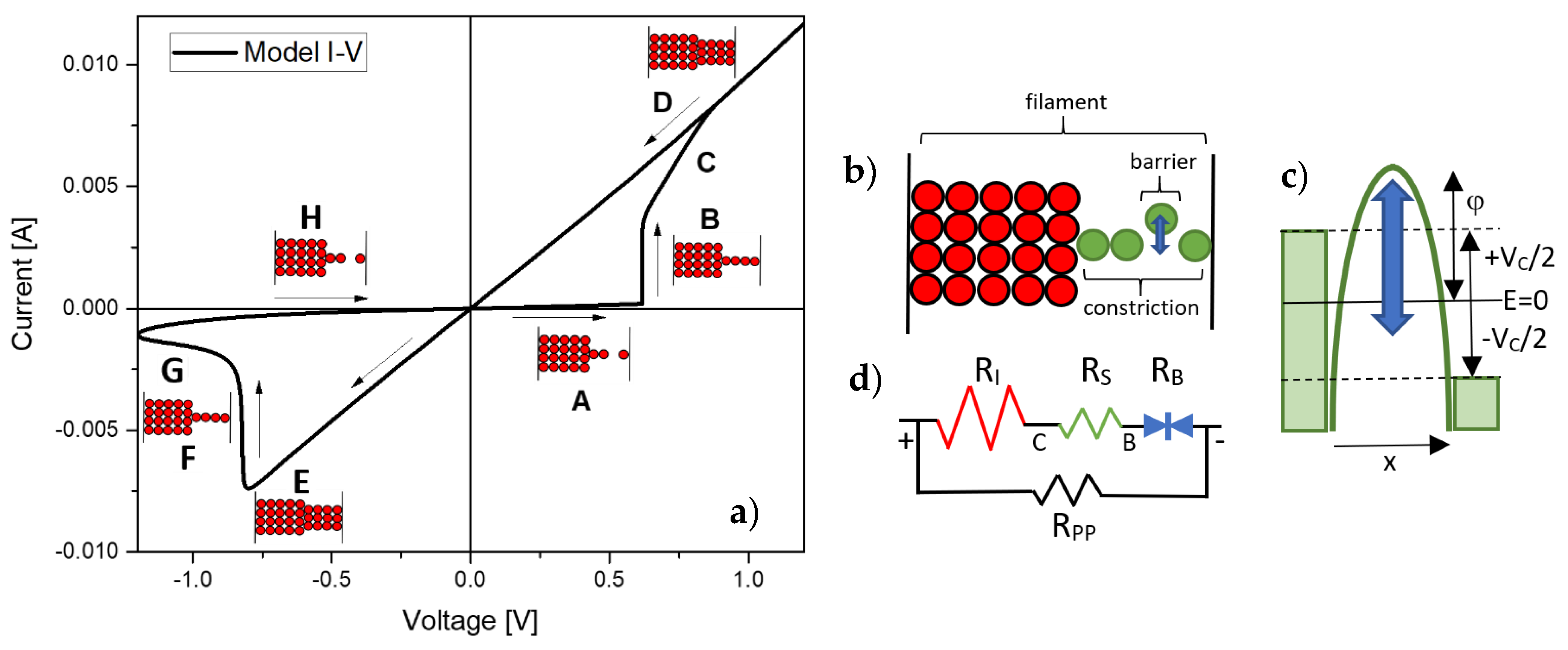
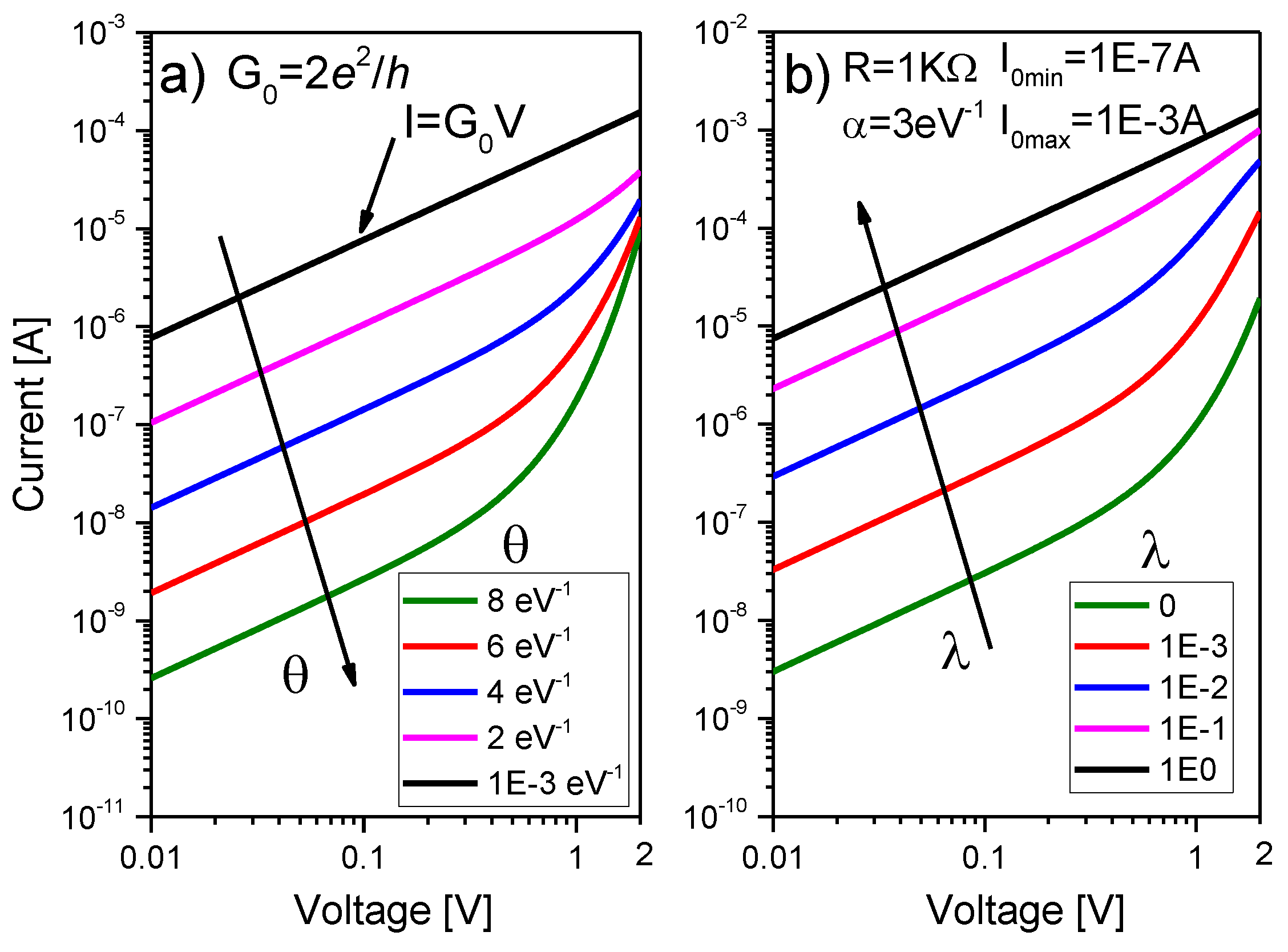
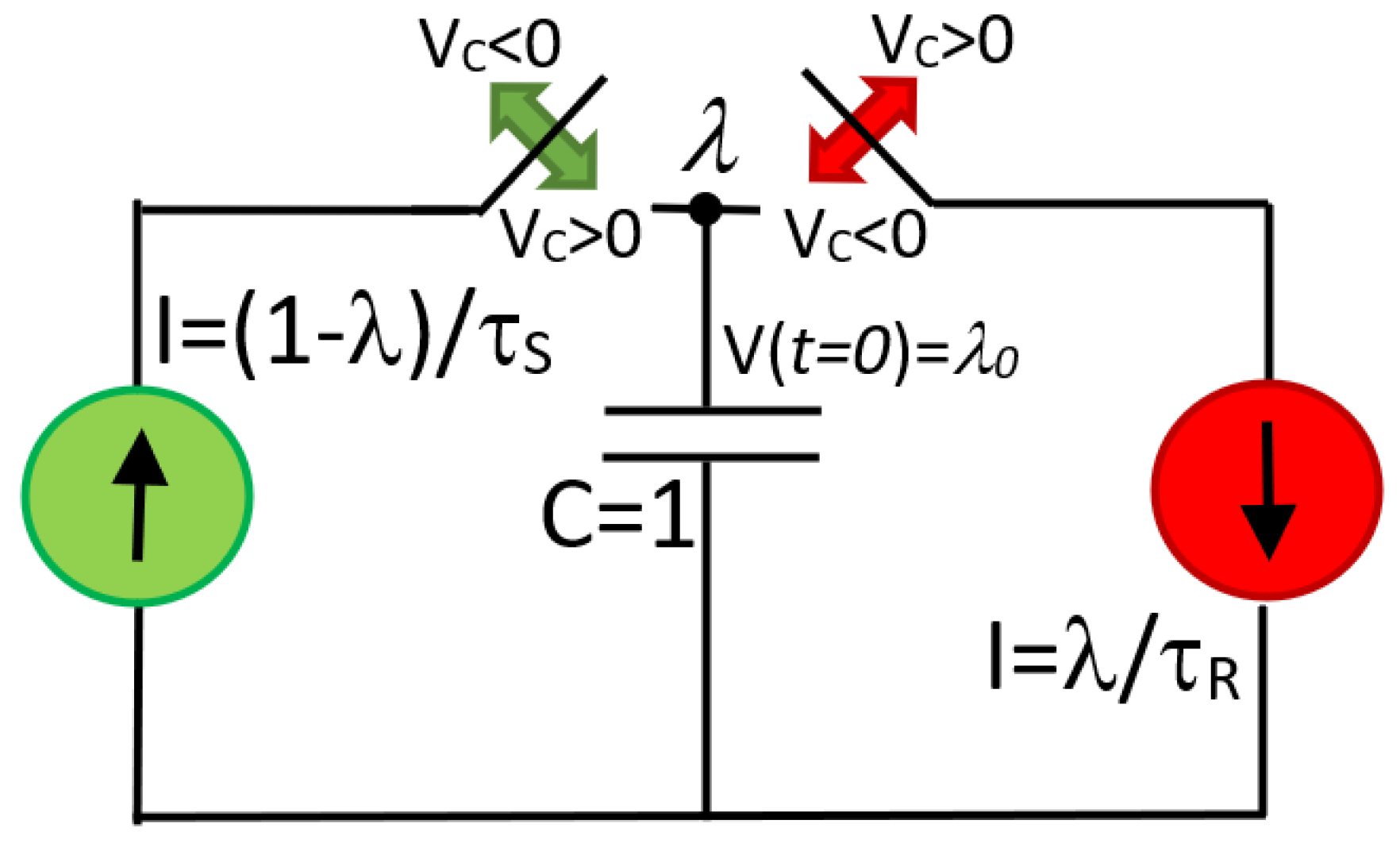


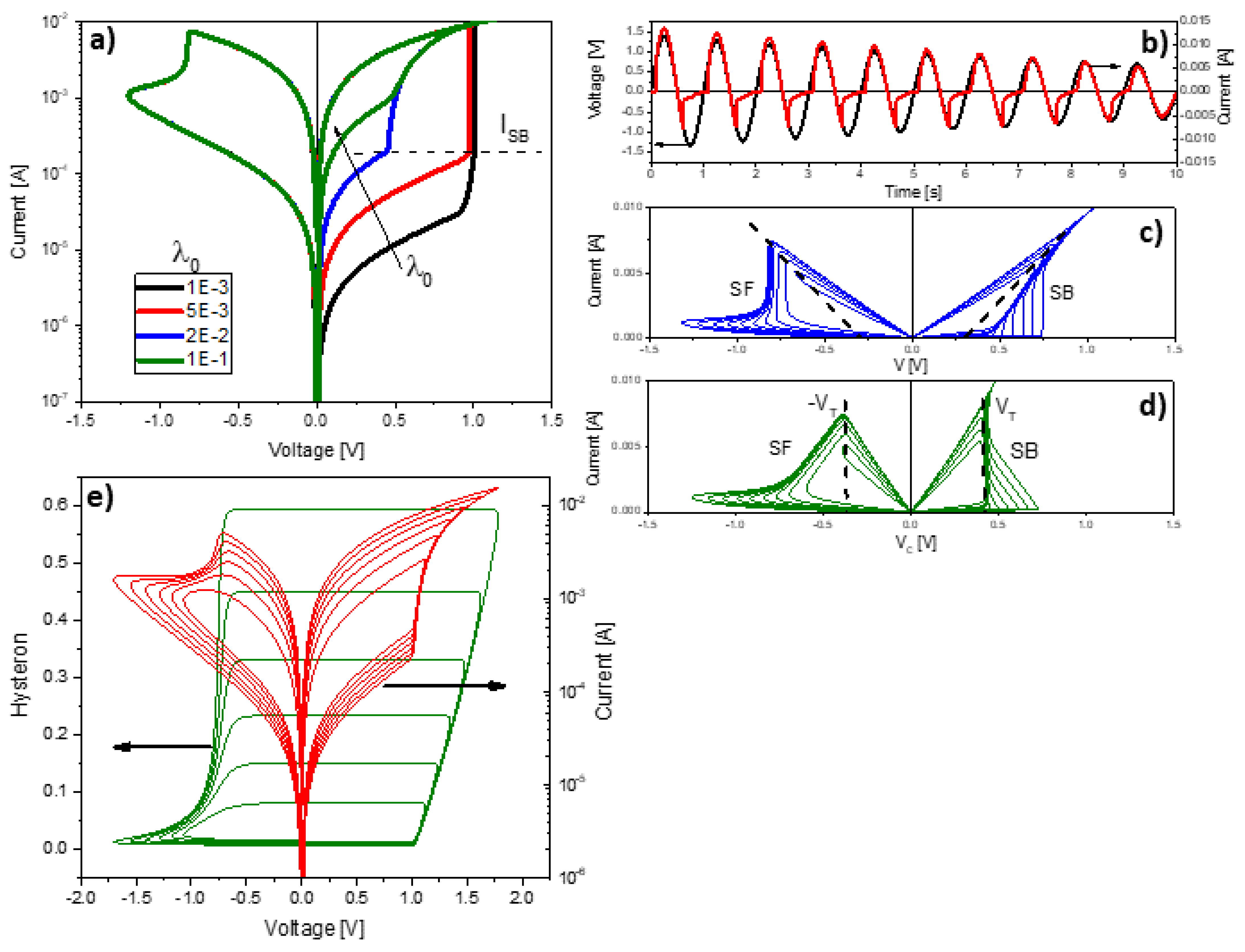


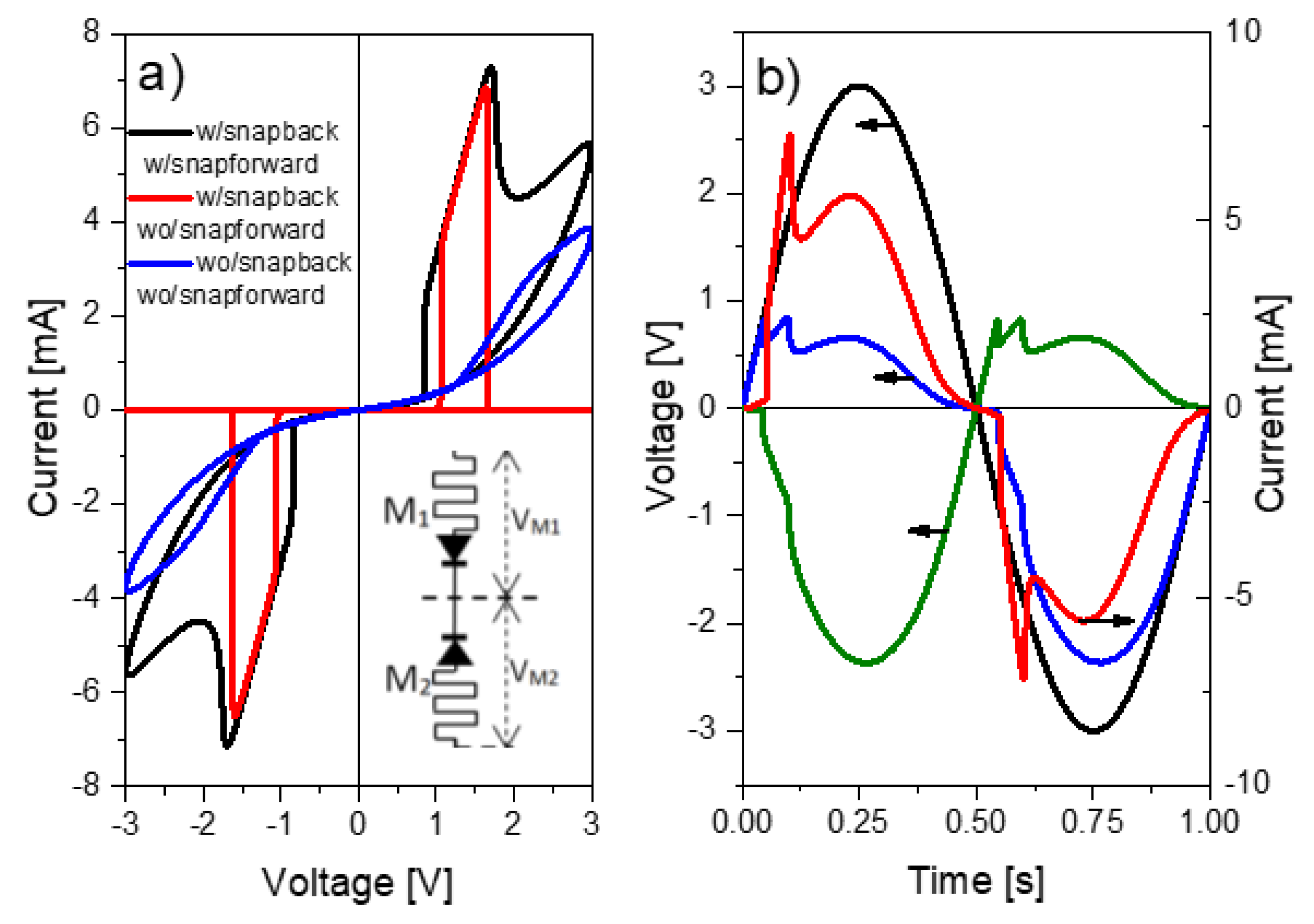
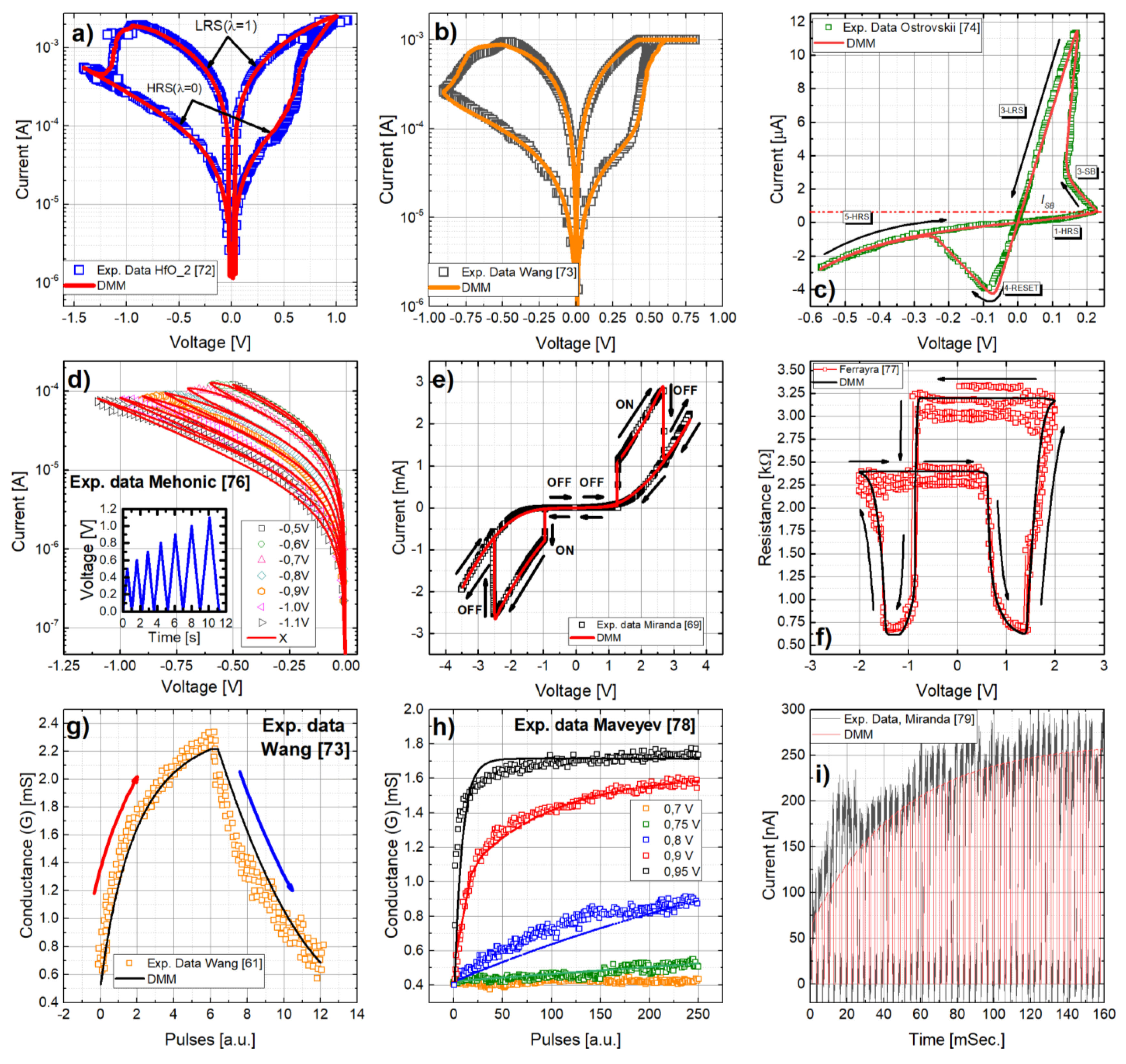
| Work | Material | Imin [A] | Imax [A] | αmin [a.u.] | αmax [a.u.] | RSmin [Ω] | RSmax [Ω] | ηSET | ηRESET | VSET [V] | VRESET [V] | ISB [A] | Gam | VT [V] |
|---|---|---|---|---|---|---|---|---|---|---|---|---|---|---|
| [72] | Ta/HfO2/Pt | 80 µ | 1.1 m | 2 | 2.75 | 100 | 150 | 8 | 10 | 600 m | −575 m | 300 µ | 0 | 350 m |
| [73] | TaOX | 75 µ | 1.5 m | 2.4 | 4 | 120 | 120 | 40 | 7 | 375 m | −130 m | 1 | 0.05 | 350 m |
| [74] | W-Ge2Se3 | 500 n | 50 µ | 4.3 | 1.75 | 10 | 10 | 50 | 250 | 200 m | −20 m | 700 n | 0.35 | 50 m |
| [76] | SiOX | 1 µ | 60 µ | 3 | 3 | 1k | 1 | 20 | 20 | 395 m | −395 m | 1 | 1 | 350 m |
| [69] | Pt/Ta2O5/Ta | 3 µ | 0.9 m | 3 | 1.75 | 160 | 160 | 50 | 50 | 2.4 | −1.35 | 60 µ | 0.3 | 0 |
| 2 µ | 0.9 m | 4 | 3 | 160 | 160 | 50 | 50 | 1.15 | −1.05 | 40 µ | 0.3 | 0 | ||
| [77] | Pt/Ta2O4.7/TaO1.67/Pt | 24.5 µ | 200 µ | 2 | 2 | 10 | 10 | 15 | 50 | 900 m | −670 m | 30 µ | 2 | 600 m |
| 17 µ | 140 µ | 2 | 2 | 100 | 100 | 100 | 50 | 750 m | −820 m | 50 µ | 3 | 650 m | ||
| [79] | Ag/ZnO/Pt | 450 p | 3.5 n | 2 | 2 | 200 | 200 | 2.4 | 10 | 1 | −1 | 1 | 0 | 1 |
Publisher’s Note: MDPI stays neutral with regard to jurisdictional claims in published maps and institutional affiliations. |
© 2022 by the authors. Licensee MDPI, Basel, Switzerland. This article is an open access article distributed under the terms and conditions of the Creative Commons Attribution (CC BY) license (https://creativecommons.org/licenses/by/4.0/).
Share and Cite
Aguirre, F.L.; Suñé, J.; Miranda, E. SPICE Implementation of the Dynamic Memdiode Model for Bipolar Resistive Switching Devices. Micromachines 2022, 13, 330. https://doi.org/10.3390/mi13020330
Aguirre FL, Suñé J, Miranda E. SPICE Implementation of the Dynamic Memdiode Model for Bipolar Resistive Switching Devices. Micromachines. 2022; 13(2):330. https://doi.org/10.3390/mi13020330
Chicago/Turabian StyleAguirre, Fernando Leonel, Jordi Suñé, and Enrique Miranda. 2022. "SPICE Implementation of the Dynamic Memdiode Model for Bipolar Resistive Switching Devices" Micromachines 13, no. 2: 330. https://doi.org/10.3390/mi13020330
APA StyleAguirre, F. L., Suñé, J., & Miranda, E. (2022). SPICE Implementation of the Dynamic Memdiode Model for Bipolar Resistive Switching Devices. Micromachines, 13(2), 330. https://doi.org/10.3390/mi13020330








